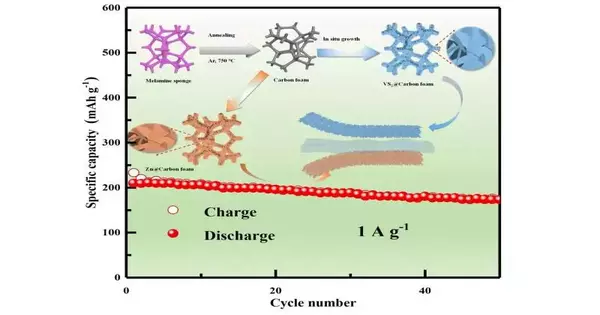An investigation just recently published in Small by a group under the direction of Prof. By growing the VS2 nanosheet arrays on carbon foam (CF) using a straightforward hydrothermal process, Zhao Bangchuan of the Hefei Institutes of Physical Science of the Chinese Academy of Sciences created a flexible vanadium disulfide material (VS2@CF).
Due to their numerous applications, wearable energy storage devices have recently become indispensable in our daily lives. Two key aspects of flexible batteries to pay attention to are flexibility and safety.
Battery comparison: hamburger The electrolyte serves as the filling between the cathode and anode, which are analogous to two slices of bread. According to Mao Yunjie, the study’s first author, “our solution is to prepare a low-cost flexible substrate (CF) by carbonizing melamine foam and fabricating flexible cathode (VS2@CF) and anode (Zn@CF).”.
“A battery is similar to a hamburger. Cathode and anode are analogous to two slices of bread, and the electrolyte is the filling; our answer is to carbonize melamine foam and manufacture flexible cathode (VS2@CF) and anode (Zn@CF).”
Mao Yunjie, first author of the study,
They created a quasi-solid zinc-ion battery with good flexibility and self-healing properties using a self-healing gel (PVA/Zn (CF3SO3)2).
Their breakthrough, one-step hydrothermal method–prepared novel aqueous Zn-storage flexible cathode material VS2@CF is the key to their success. The cathode has a large surface area, flexible architecture, high electronic and ionic conductivity, abundant active sites, and good hydrophilicity.
A very long life cycle and exceptional rate capability are features of the VS2@CF cathode. It’s impressive that the flexible, quasi-solid-state zinc-ion batteries with the VS2@CF cathode, Zn@CF anode, and PVA/Zn (CF3SO3)2 self-healing gels can still function normally in terms of charging and discharging under a variety of bending angles and have good self-healing properties.
The PVA/Zn (CF3SO3)2 self-healing gels offered a fresh concept for the design of wearable electronic devices, and the CF offered a low-cost flexible electrode substrate for flexible energy storage devices.
More information: Yunjie Mao et al, Carbon Foam‐Supported VS 2 Cathode for High‐Performance Flexible Self‐Healing Quasi‐Solid‐State Zinc‐Ion Batteries, Small (2023). DOI: 10.1002/smll.202207998





